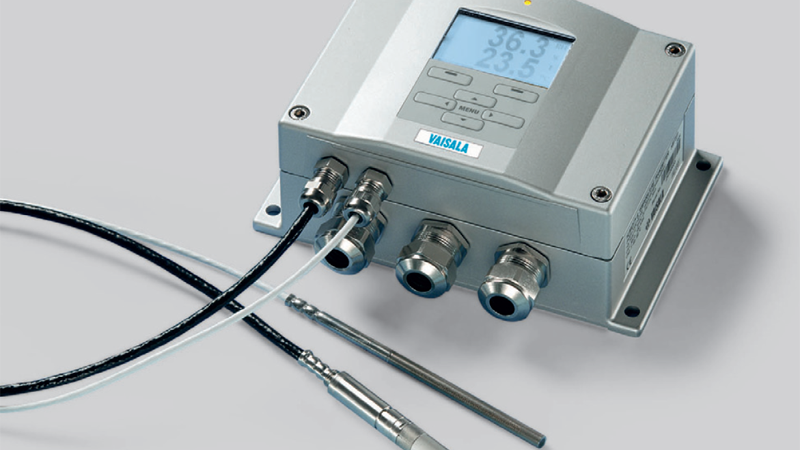Help! My RH sensor’s saturated and my data is wrong…
The Genesis of Heated Probe Technology
This is the last in a trio of technology-focused posts about relative humidity sensor innovations and modifications. The first post was about probe pre-warming for applications where the dewpoint temperature is above ambient temperature. The second post was about the chemical purge function for sensors operating amidst airborne contamination. Today, we are talking about heated probes (different from pre-warming or chemical purge). I'll explain how these probes are used in extreme conditions. But first, some background…
We Measure the Sky (but the devices work for other stuff)
Vaisala has a long history providing meteorological equipment. Originally, we created systems to measure atmospheric conditions called sounding systems. These systems measure temperature, humidity, air pressure, wind direction and speed, and other parameters. One example is the Ceilometer used to determine cloud height. (To learn more about these technologies, check out our meteorological systems.)
As the originator of several meteorological technologies, Vaisala is often the first stop for people in the weather business with new and interesting measurement challenges. This has put us in the position of further innovating and modifying sensors to troubleshoot issues encountered in the field. Those solutions have often found uses in other applications, across many industries. The heated RH probe is one such.
It's 40 below and My RH Sensor is Glitchy
This modification was developed by Vaisala when researchers working in Antarctica discovered that their relative humidity measurements were flawed. Condensation was forming on the sensors in the form of frost and instrument readings then indicated air saturation (100% RH). This is typical if the sensor becomes wet or covered with ice, but it's a real problem when your research is based on data on climatic conditions. (Read more on this research and the solution -> see the attached PDF below.)
When in Doubt, Innovate
Vaisala engineers addressed this problem with a novel approach. We designed a probe with a relative humidity sensor at the tip that always gives a reading of about 80% RH. This is achieved by building a small heater into the end of the probe. The heater is controlled by an algorithm that responds to the humidity measurement and adjusts the probe heater to keep the probe at an RH level no higher than 80% RH. When actual conditions approach saturation, the probe still shows 80% RH. Its temperature is higher than the surrounding air temperature at this point, so dew/frost cannot form on the sensor.
Of course, a corrupted measurement of 80% RH is not useful. It has been manipulated into existence and does not accurately reflect the atmospheric conditions. To counter this, a platinum resistance thermometer is bonded to the RH sensor. Both sensors are at the same temperature. In this way, RH and temperature are both known and dewpoint temperature is easily calculated. If relative humidity is the desired parameter, a separate air temperature measurement is made and RH is back calculated using air temperature and dewpoint.
Works in Antarctica…Let's try it in Test Chambers
This is a pretty good scheme. Although it was designed for weather measurement, we on the industrial side of the business have found many good uses for it. It's a perfect solution for high humidity environments where the RH level is close to 100%. Most humidity sensors do not perform well in these conditions when there is long-term continuous exposure, as would occur in environmental test chambers that are often used for accelerated life testing.
This probe works best when the surrounding environment is stable in terms of rate of change because a probe-heating system may not be able to keep up with rapid changes. As a last ditch effort, the probe can be programmed to immediately go to full heat when the RH measurement reaches a threshold on its way to saturation. Heating includes direct excitation of the platinum resistance thermometer that is bonded to the RH sensor (just like chemical purge and probe pre-warming). This generally prevents condensation, but the measurement is not valid during this process.
In essence, this is the simple explanation of heated probes: the entire probe is warmed 2...3 degrees above ambient temperature. This prevents condensation on the sensor, even in a saturated environment.
However, the heating prevents a true RH reading so the output is dewpoint temperature. (Dewpoint measurement is not affected by temperature.) In some applications, folks use a separate temperature probe for calculating RH. (note the two probes in the image.)
Since its inception, the heated probe has found many applications where they are near ideal, including concrete curing rooms, high humidity testing chambers, and (of course) they are used worldwide in outdoor measurements.
Comments, Questions and Suggestions Welcome!
This concludes our three-part series of probe modifications and technologies. For more information on heated probes, see the application note attached below. But this is not the end or our technology posts. We have a few more tricks up our collective sleeves for measuring other interesting parameters, such as: dewpoint temperature and carbon dioxide concentration. If you have a pesky parameter dogging you, please let us know with a comment below. If I can't answer it, I can find someone who can.
In fact, recently when the blog editor received a technical question on this recent publication: "Understanding Measurement Performance and Specifications" (below) she forwarded the question to the author, Industry Expert and Engineer Jarkko Ruonala. She accidentally emailed the wrong Jarkko (as a Finnish company, we have several). Fortunately, the other Jarkko happened to be an engineer well familiar with the question posed, and he answered at length. So, if you have a question about measuring a parameter, simply ask. Someone will either know the answer, figure it out, or create a way to measure it.
James Tennermann

Comment
Add new comment